Women in the Workplace 2025
The 11th Annual Report

Many companies are overlooking women—and it’s critical they don’t
This year, only half of companies are prioritizing women’s career advancement, part of a trend in declining commitment to gender diversity.1 Moreover, some companies are not prioritizing women at all. Two in 10 say they are placing low or no priority on women’s career advancement, and this rises to 3 in 10 for women of color.2 There are other signs that women are being overlooked. One in 4 companies now offer fewer remote and hybrid work options, and almost 1 in 6 cut back on formal sponsorship and discontinued or scaled back career development programs with content tailored for women.3
It’s critical that companies focus on advancing and supporting women; those that do have a higher representation of women and have seen accelerated progress over the past several years.4
6 Things Everyone Needs to Know:
-
01
Women are now less interested in advancing
For the first time, women are notably less likely than men to say they want to be promoted.
-
02
The “broken rung” still holds women back
For the 11th year, women are held back by a broken rung at the first step up to manager.
-
03
Women leaders are under extra pressure
Senior-level women are struggling with high burnout and see a steeper path to the top.
-
04
Flexibility stigma hurts women
Women are often penalized for working remotely; in contrast, men are not.
-
05
Diversity matters to corporate America
A majority of companies are prioritizing diversity—but commitment is trending down.
-
06
Fairness and inclusion pay off
Employees value fair opportunities and a respectful culture—but there’s work to be done.
01
Women are now less interested in advancing

For the first time, women are notably less likely than men to say they want to be promoted
Women and men at all levels are equally committed to their careers and motivated to do their best work. But for the first time, there is a notable ambition gap: 80% of women want to be promoted to the next level, compared to 86% of men—and the gap widens significantly at entry and senior levels.
Companies can change this. Many women are held back because they get less sponsorship and manager advocacy—for example, entry-level women are less likely to be put up for promotion or connected with someone who can help their career.5 But when women receive the same career support that men do, they are just as interested in advancing. The gap in ambition to advance falls away.6
A closer look
This year, women are less interested in advancing than men7
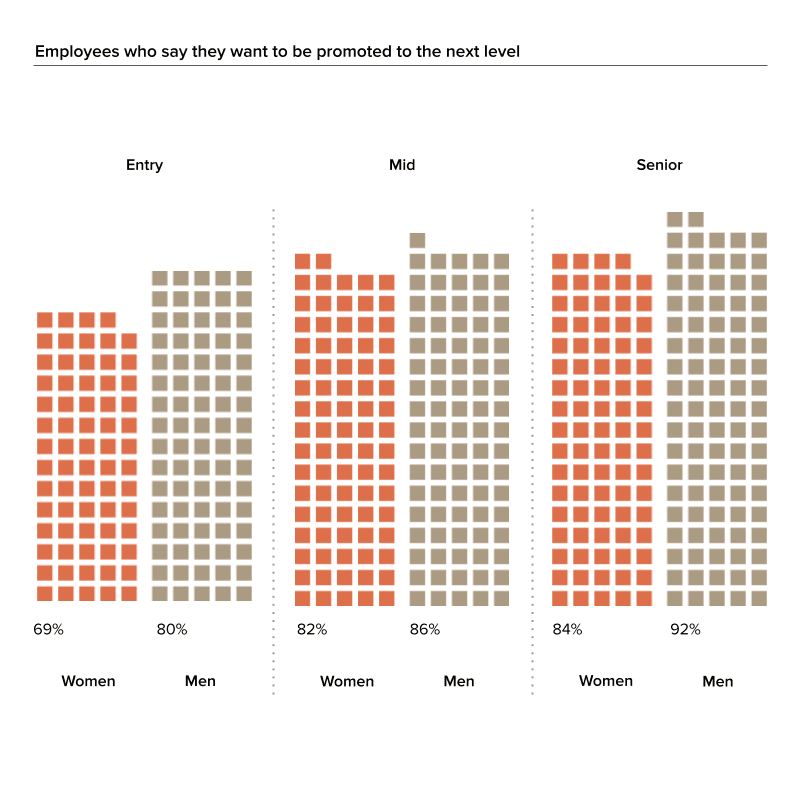
Circles help employees go farther
Research shows that support from employees at the same level can be just as effective as traditional mentorship. Lean In Circles tap into the power of “peer mentorship” by bringing small groups together to learn new skills and give and get advice.
Learn More02
The “broken rung” still holds women back

For the 11th year, women are held back by a broken rung at the first step up to manager
For every 100 men promoted to manager last year, only 93 women were promoted, and the numbers are worse for women of color: just 82 Asian women and Latinas and 60 Black women were promoted.8 As a result, men significantly outnumber women at the manager level, and women can never catch up.
This broken rung is one of many signs that women are disadvantaged at the beginning of their careers. Only 31% of entry-level women have a sponsor, compared to 45% of men at their level.9 They are also less likely to have a more senior coworker put them up for promotion or introduce them to someone who can help their careers. And entry-level women are far less likely to have the opportunity to be people managers, which means they’re less likely to be on a path to advancement. Perhaps as a result, entry-level women stand out for being the least likely to think their workplace is fair.10
A closer look
Entry-level women are less likely to have more senior colleagues open doors for them

Ensure performance reviews are fair
Even when companies have good performance review practices in place, they’re not always implemented effectively. Adding real-time check-ins—like prompting evaluators to explain their decisions—can help.
Learn More03
Women leaders are under extra pressure

Senior-level women are struggling with high burnout and see a steeper path to the top
Women in leadership have long experienced more burnout than other employees, and this year their burnout is higher than ever.11 Six in 10 senior-level women report frequently feeling burned out, compared to only half of men at their level and about 4 in 10 employees overall. Senior-level women are also more likely than other employees to think their gender will make it harder for them to advance and are particularly concerned about their job security this year.12
When women in leadership are not interested in advancing, they are more likely to point to having been passed over for promotion and to not seeing a realistic path forward.13 They’re also far more likely to think the leaders above them are highly burned out and unhappy in their roles.14
A closer look
Senior-level women stand out for high levels of burnout and job insecurity
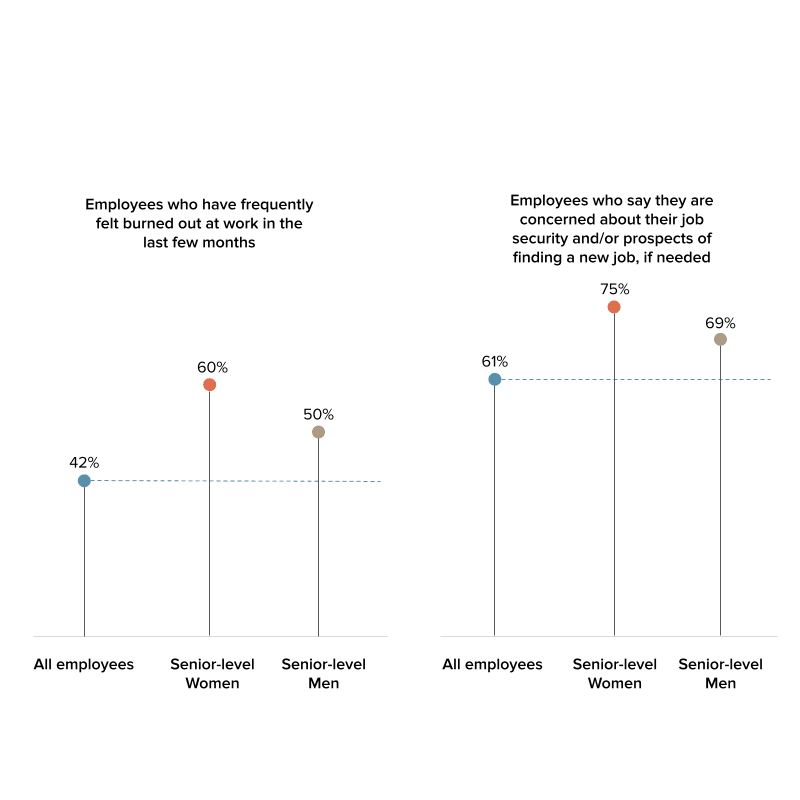
Free managers up to provide 1:1 support
Look for ways to reduce the time managers spend on routine tasks so they can focus more on connecting with their teams—coaching people, getting to know their strengths, and understanding what they need to do their best work.
Learn More04
Flexibility stigma hurts women

Women are often penalized for working remotely; in contrast, men are not
Only a third of women who work mostly remotely have received a promotion in the last two years or benefit from having a sponsor, compared to over half of women who work mostly on-site. In contrast, regardless of where they work, outcomes are relatively similar for men. This pattern is partially explained by research that shows coworkers often assume women who use flexible work arrangements are less productive and engaged, while men don’t face this stigma.15 “Flexibility stigma” is particularly problematic for women given they are more likely to take advantage of flexible work.16
On top of this, workplace flexibility is on the decline. This year, 1 in 4 companies discontinued or scaled back their remote and hybrid work options—the largest rollback of any HR policy—and more than 1 in 8 limited flexible work hours.17
A closer look
Women who work mostly remote miss out on sponsorship and promotions
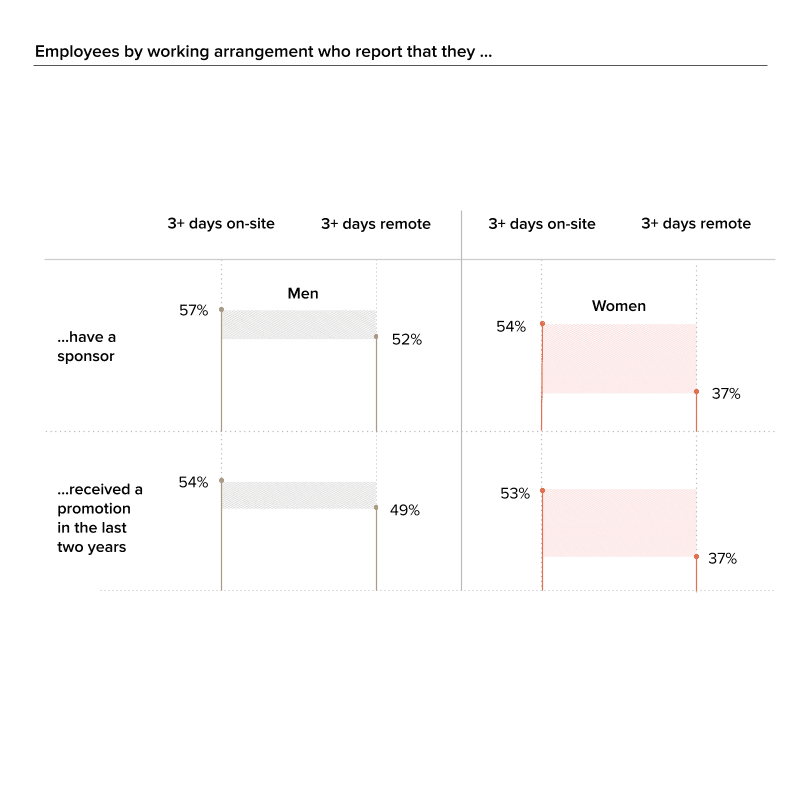
Make sure everyone gets an equal shot
Encourage managers to share stretch opportunities with all eligible team members and reinforce why they’re so important. And make sure they know to focus on skills—and not on personal preferences or arbitrary criteria—when they’re deciding who gets these opportunities.
Learn More05
Diversity still matters in corporate America

A majority of companies are prioritizing diversity—but commitment is trending down
This year, 67% of companies report diversity is a high priority, and 84% remain committed to inclusion. In addition, similar percentages of companies have maintained the level of staff and resources focused on diversity and inclusion.18 However, some companies have walked back their efforts. Two in 10 companies have stopped or scaled back their bias training—and similar numbers have reduced their overall investment in fostering diversity.19
To put this year in perspective, in 2021, 90% of companies reported that diversity and inclusion was a high organizational priority, the highest level of commitment across this study.20
A closer look
The priority companies have placed on diversity and inclusion has declined over time

Choose trainings that really work
Inclusion trainings can be ineffective or leave employees feeling defensive, but research shows high-quality sessions really work. Look for options that treat employees with respect, focus on practical recommendations, and encourage participation.
Learn More06
Fairness and inclusion pay off

Employees value fair opportunities and a respectful culture—but there’s work to be done
Employees almost universally agree: hiring and promotions should be fair. People are motivated when they feel respected and valued. And a variety of perspectives leads to better decision-making.
However, many women outside of leadership still experience an uneven playing field and feel reluctant to speak up. Entry- and mid-level women are far less likely than other employees to believe that opportunities are fair and everyone receives the support they need to succeed.21 And although women at all levels generally feel appreciated, entry- and mid-level women are less comfortable disagreeing with coworkers and taking risks—which means companies are missing out on their best thinking.22
To unlock the full potential of women and all employees, companies need to double down in two areas that have always mattered: offering fairness of opportunity and fostering an inclusive culture. Getting this right pays off. When employees see their company as fair and inclusive, they are more motivated and less burned out, more likely to disagree and take risks, and less likely to consider leaving.23
A closer look
Employees value unbiased processes, respectful workplaces, and varied perspectives
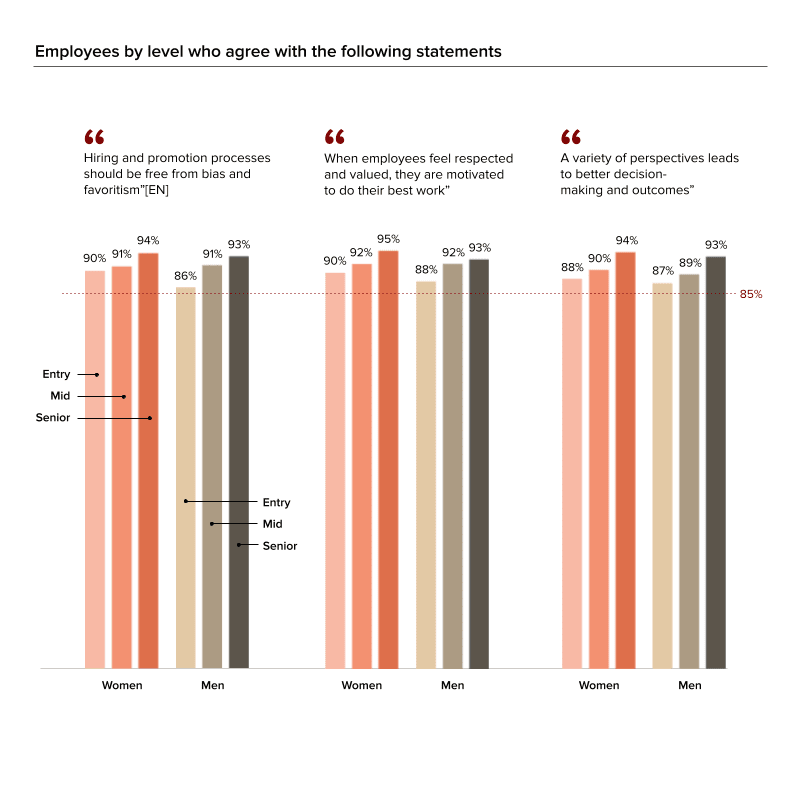
A road map for fairness and inclusion
This year’s report offers detailed recommendations for improving fairness of opportunity and fostering an inclusive culture—supported by insights from this year’s study, third-party research, and interviews with HR leaders.
Learn More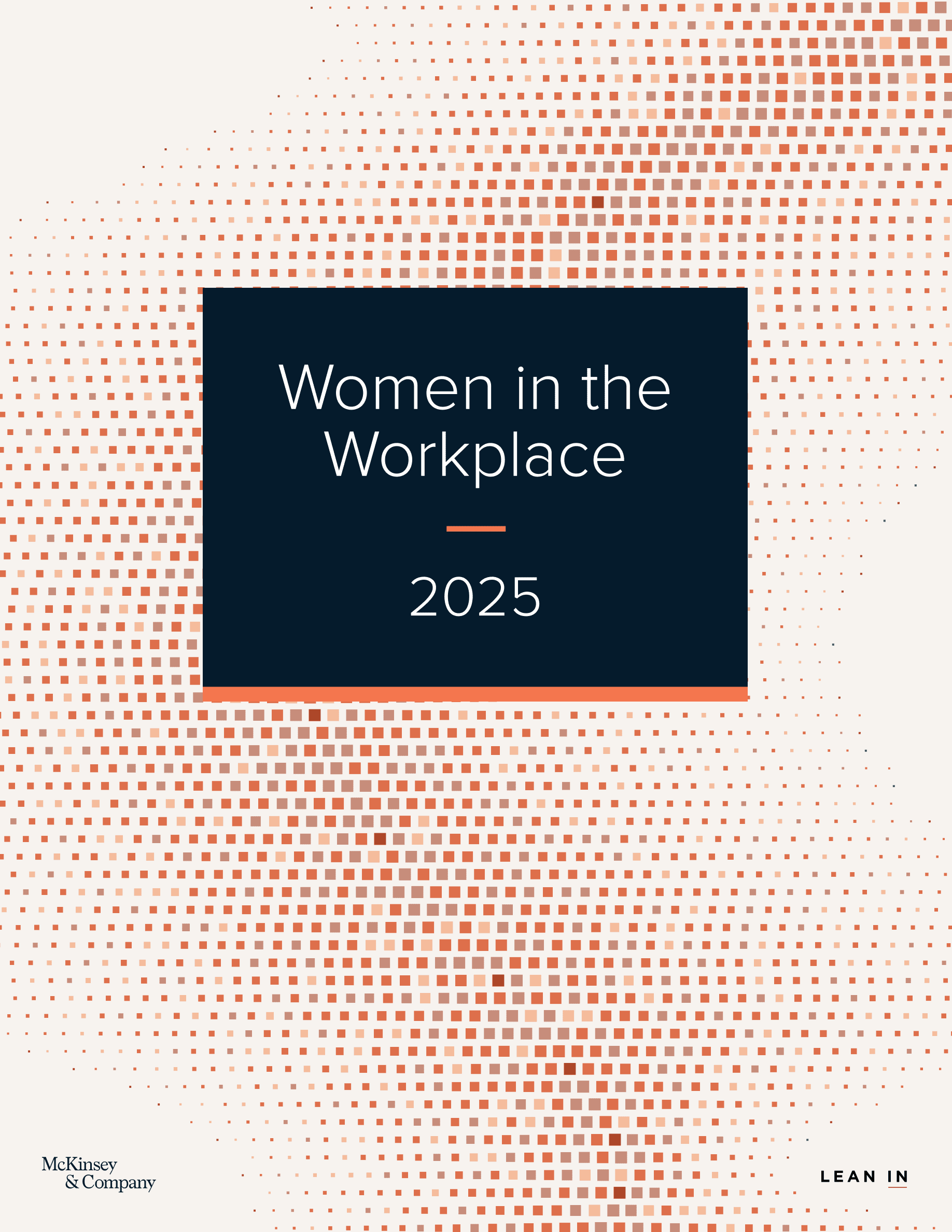
Women in the Workplace 2025 includes:
Past Reports
2024
Women in leadership positions are steadily rising, but progress is slow. Workplace culture, biases, and stalled early-career advancement are hindering parity for women of color.
Read the Report
Women in leadership positions are steadily rising, but progress is slow. Workplace culture, biases, and stalled early-career advancement are hindering parity for women of color.
Read the Report
Women in leadership positions are steadily rising, but progress is slow. Workplace culture, biases, and stalled early-career advancement are hindering parity for women of color.
Read the ReportWomen in leadership positions are steadily rising, but progress is slow. Workplace culture, biases, and stalled early-career advancement are hindering parity for women of color.
Read the ReportThe 2024 report shows that while women’s representation in leadership continued to rise, progress remained uneven. Early career advancement is slow and women of color still face persistent bias and microaggressions. While men view progress more optimistically, women live a different reality at work.
Read the Report
2023
The ninth year of the Women in the Workplace study debunks four myths about women’s workplace experiences and career advancement.
Read the Report
The ninth year of the Women in the Workplace study debunks four myths about women’s workplace experiences and career advancement.
Read the Report
The ninth year of the Women in the Workplace study debunks four myths about women’s workplace experiences and career advancement.
Read the ReportThe ninth year of the Women in the Workplace study debunks four myths about women’s workplace experiences and career advancement.
Read the ReportA few of these myths cover old ground, but given the notable lack of progress, they warrant repeating. A few have re-emerged and intensified with the shift to flexible work. The future of work for women depends on casting aside this outdating thinking—and the 2023 report provides a road map.
Read the Report
2022
Women are demanding more from work, and they’re leaving their companies in unprecedented numbers to get it.
Read the Report
Women are demanding more from work, and they’re leaving their companies in unprecedented numbers to get it.
Read the Report
Women are demanding more from work, and they’re leaving their companies in unprecedented numbers to get it.
Read the ReportWomen are demanding more from work, and they’re leaving their companies in unprecedented numbers to get it.
Read the ReportWomen leaders are switching jobs at the highest rate we’ve ever seen—and at a higher rate than men in leadership. This could have serious implications for companies. Women are already significantly underrepresented in leadership. For years, fewer women have risen through the ranks because of the “broken rung” at the first step up to management. Now, companies are struggling to hold on to the relatively few women leaders they have. And all of these dynamics are even more pronounced for women of color.
Read the Report
2021
The events of 2020 put extraordinary pressure on companies and employees. Women leaders are meeting the moment and taking on the extra work that comes with it.
Read the Report
The events of 2020 put extraordinary pressure on companies and employees. Women leaders are meeting the moment and taking on the extra work that comes with it.
Read the Report
The events of 2020 put extraordinary pressure on companies and employees. Women leaders are meeting the moment and taking on the extra work that comes with it.
Read the ReportThe events of 2020 put extraordinary pressure on companies and employees. Women leaders are meeting the moment and taking on the extra work that comes with it.
Read the ReportCompared to men at the same level, women are doing more to support their teams and advance inclusion. They are also more likely than men to practice allyship. Yet their efforts are going unrecognized and unrewarded. This has serious implications: It hurts women, who are investing disproportionate time and energy in these priorities. And it hurts companies and all employees, because progress is rarely made on efforts that are undervalued.
Read the Report
2020
Companies risk losing women in leadership—and future women leaders—and unwinding years of painstaking progress toward gender diversity.
Read the Report
Companies risk losing women in leadership—and future women leaders—and unwinding years of painstaking progress toward gender diversity.
Read the Report
Companies risk losing women in leadership—and future women leaders—and unwinding years of painstaking progress toward gender diversity.
Read the ReportCompanies risk losing women in leadership—and future women leaders—and unwinding years of painstaking progress toward gender diversity.
Read the ReportOne in 4 women are considering downshifting their careers or leaving the workforce due to COVID-19.
This year’s report makes one thing clear: corporate America is at a critical crossroads. Without bold steps, we could erase all the progress we’ve made toward gender diversity in the six years of this study. But if companies rise to the moment, we can lay the foundation for a more flexible and equitable workplace in the long term.
2019
We see bright spots at senior levels. But companies need to focus their efforts earlier in the pipeline to fix the “broken rung” problem and make real progress.
Read the Report
We see bright spots at senior levels. But companies need to focus their efforts earlier in the pipeline to fix the “broken rung” problem and make real progress.
Read the Report
We see bright spots at senior levels. But companies need to focus their efforts earlier in the pipeline to fix the “broken rung” problem and make real progress.
Read the ReportWe see bright spots at senior levels. But companies need to focus their efforts earlier in the pipeline to fix the “broken rung” problem and make real progress.
Read the ReportIn the last five years, we’ve seen more women rise to the top levels of companies. Yet women continue to be underrepresented at every level. To change the numbers, companies need to focus on where the real problem is. We often talk about the “glass ceiling” that prevents women from reaching senior leadership positions. In reality, the biggest obstacle that women face is much earlier in the pipeline, at the first step up to manager. Fixing this “broken rung” is key to achieving parity.
Read the Report
2018
Women are doing their part. Now companies need to do their part, too.
Read the Report
Women are doing their part. Now companies need to do their part, too.
Read the Report
Women are doing their part. Now companies need to do their part, too.
Read the ReportWomen are doing their part. Now companies need to do their part, too.
Read the ReportFor the last four years, companies have reported that they are highly committed to gender diversity in the workplace. But that commitment has not translated into meaningful progress.
Women continue to be vastly underrepresented at every level. For women of color, it’s even worse. Only about 1 in 5 senior leaders is a woman, and 1 in 25 is a woman of color.
Progress isn’t just slow—it’s stalled. And we know why.
2017
While company commitment to gender diversity is at an all-time high, getting to gender equality starts with realizing how far we have to go.
Read the Report
While company commitment to gender diversity is at an all-time high, getting to gender equality starts with realizing how far we have to go.
Read the Report
While company commitment to gender diversity is at an all-time high, getting to gender equality starts with realizing how far we have to go.
Read the ReportWhile company commitment to gender diversity is at an all-time high, getting to gender equality starts with realizing how far we have to go.
Read the ReportWomen remain underrepresented at every level in corporate America, despite earning more college degrees than men for 30 years and counting. There is a pressing need to do more, and most organizations realize this: company commitment to gender diversity is at an all-time high for the third year in a row.
Read the Report
2016
In corporate America, women fall behind early and continue to lose ground with every step.
Read the Report
In corporate America, women fall behind early and continue to lose ground with every step.
Read the Report
In corporate America, women fall behind early and continue to lose ground with every step.
Read the ReportIn corporate America, women fall behind early and continue to lose ground with every step.
Read the ReportWomen are less likely to receive the first critical promotion to manager—so far fewer end up on the path to leadership—and are less likely to be hired into more senior positions. Women also get less access to the people, input, and opportunities that accelerate careers. As a result, the higher you look in companies, the fewer women you see.
This disparity is especially pronounced for women of color, who face the most barriers to advancement and experience the steepest drop-offs with seniority.
2015
Corporate America is not on a path to gender equality as women are still underrepresented at every level in the corporate pipeline.
Read the Report
Corporate America is not on a path to gender equality as women are still underrepresented at every level in the corporate pipeline.
Read the Report
Corporate America is not on a path to gender equality as women are still underrepresented at every level in the corporate pipeline.
Read the ReportCorporate America is not on a path to gender equality as women are still underrepresented at every level in the corporate pipeline.
Read the ReportMany people assume this is because women are leaving companies at higher rates than men or due to difficulties balancing work and family. However, our analysis tells a more complex story: women face greater barriers to advancement and a steeper path to senior leadership.
Read the ReportMore Resources
Bring Circles for Companies to your organization
Circles bring small groups together to learn and grow—and members become more effective and inclusive leaders.
Learn MoreAdd 50 Ways to Fight Bias to your employee trainings
Women continue to experience bias at work—50 Ways focuses on specific things all employees can say and do.
Learn MoreGo farther in your career with the support of a Lean In Circle
Lean In Circles combine a leadership curriculum with the power of camaraderie and support—[all] at no cost to you.
Learn MoreFootnotes
- Full question: “How much of a priority are the following for your organization right now? Women’s career advancement.” Respondents selected: “A top priority” or “A very important priority.”
- Full question: “How much of a priority are the following for your organization right now? Women’s career advancement.” Respondents selected: “Not a priority” or “A slightly important priority.” Full question: “How much of a priority are the following for your organization right now? Women of color’s career advancement.” Respondents selected: “Not a priority” or “A slightly important priority.”
- Full question: “In the last 12 months, how has each of the following changed at your organization? Flexible working hours.” Respondents selected: “Scaled back or discontinued.” Full question: “In the last 12 months, how has each of the following changed at your organization? Remote/hybrid work options.” Respondents selected: “Never offered in a meaningful way” or “Scaled back or discontinued.” Full question: “In the last 12 months, how has each of the following changed at your organization? Formal sponsorship programs.” Respondents selected: “Never offered in a meaningful way” or “Scaled back or discontinued.” Full question: “In the last 12 months, how has each of the following changed at your organization? Career development programs with content tailored for women.” Respondents selected: “Never offered in a meaningful way” or “Scaled back or discontinued.”
- Women’s representation data from 2021 to 2024 were analyzed to identify top and bottom quartiles by company performance, where performance is measured by representation of women, relative to industry benchmarks. HR program and policy data were linked to determine the share of companies implementing specific practices. A practice was considered top performing if implementation differences between top and bottom quartiles were statistically significant in 2024 and in 2021. The difference was at least 25 percentage points in 2024.
- Full question: “In the last 12 months, has someone in a more senior role than you (other than your direct manager) done any of the following for you? Select all that apply.” Respondents selected: “Put you forward as a candidate for promotion.” Full question: “In the last 12 months, has someone in a more senior role than you (other than your direct manager) done any of the following for you? Select all that apply.” Respondents selected: “Connected you with someone who could help your career development.”
- The five supports most strongly correlated with interest in being promoted at each level were used to create a composite indicator for receiving at least three of these supports; interest in being promoted was then examined by composite status.
- For more details on data visualizations, see report endnotes.
- Full question: “Do you want to be promoted to the next level?” Respondents selected: “Yes.”
- Full question: “Do you have a sponsor at work (i.e., someone other than your direct manager who actively advocates for your career advancement and/or creates opportunities for you)?” Respondents selected: “Yes, I have multiple sponsors” or “Yes, I have one sponsor.”
- Full question: “How fair do you believe your workplace is (i.e., all employees receive the support they need to succeed and similar opportunities to advance)?” Respondents selected: “Fair.”
- LeanIn.Org and McKinsey & Company, Women in the Workplace 2024, October 2024; Women in the Workplace 2023, October 2023; Women in the Workplace 2022, October 2022; Women in the Workplace 2021, September 2021; Women in the Workplace 2020, October 2020.
- Full question: “Going forward, do you think that any of the following personal characteristics will contribute to you missing out on a raise, promotion, or chance to get ahead at your organization?” Respondents selected: “Your gender.”
- Full question: “Why don't you want to be promoted to the next level? Select all that apply.” Respondents selected: “I have been passed over for promotions,” and/or “I don't see a path to promotion that feels realistic for me.”
- Full question: “Why don't you want to be promoted to the next level? Select all that apply.” Respondents selected: “People at higher levels seem burned out and/or unhappy in their roles.”
- Robin Ely, “What’s Really Holding Women Back,” Harvard Business Review, March 2020, https://hbr.org/2020/03/whats-really-holding-women-back; Special Issue: The Flexibility Stigma, Journal of Social Issues 69 (June 2013), https://spssi.onlinelibrary.wiley.com/toc/15404560/2013/69/2.
- LeanIn.Org and McKinsey & Company, Women in the Workplace 2023, October 2023, https://leanin.org/women-in-the-workplace/2023.
- Full question: “In the last 12 months, how has each of the following changed at your organization? Flexible working hours.” Respondents selected: “Scaled back or discontinued.” Full question: “In the last 12 months, how has each of the following changed at your organization? Remote/hybrid work options.” Respondents selected: “Scaled back or discontinued.”
- Full question: “In the last 12 months, how has each of the following changed at your organization? Staff and resources focused on supporting diversity.” Respondents selected: “Maintained as before.” Full question: “In the last 12 months, how has each of the following changed at your organization? Staff and resources focused on supporting inclusion.” Respondents selected: “Maintained as before.”
- Full question: ““In the last 12 months, how has each of the following changed at your organization? Training on how to identify and interrupt workplace bias.” Respondents selected: “Scaled back or discontinued.” Full question: “In the last 12 months, how has each of the following changed at your organization? Staff and resources focused on supporting diversity.” Respondents selected: “Scaled back or discontinued.”
- See previous reports: LeanIn.Org and McKinsey & Company, Women in the Workplace 2024, October 2024; Women in the Workplace 2023, October 2023; Women in the Workplace 2022, October 2022; Women in the Workplace 2021, September 2021; Women in the Workplace 2020, October 2020; Women in the Workplace 2019, October 2019; Women in the Workplace 2018, October 2018; Women in the Workplace 2017, October 2017; Women in the Workplace 2016, October 2016; Women in the Workplace 2015, October 2015.
- Full question: "How much do you agree or disagree with the following statement about your organization? The best opportunities go to the most deserving employees." Respondents selected: "Agree." Full question: "How much do you agree or disagree with the following statement about your organization? All employees receive the support to succeed." Respondents selected: "Agree."
- Full question: “How much do you agree or disagree with the following statements in relation to your organization? I feel comfortable disagreeing with others.” Respondents selected: “Agree.”
- For more details, see report endnotes.
